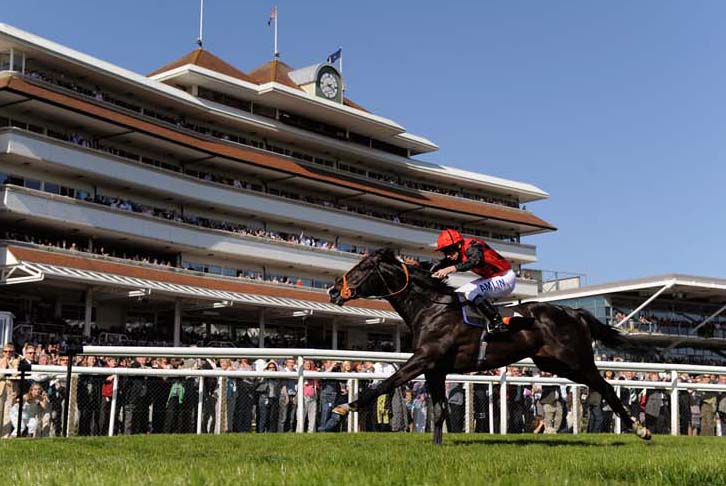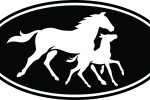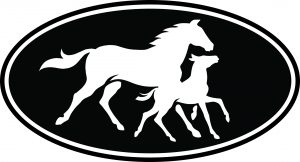Dominic Burke stood at the panoramic window of his ninth-floor office in the City of London and jabbed a finger – part identification, part accusation – at the nearby high-rises housing his rivals in the insurance sector. Soon, his combative nature emerged again as he turned to his out-of-hours role in what many would consider the tortured post of Newbury racecourse Chairman.
Burke has not achieved his position in the city, as CEO of JLT, by being negative or bashful. In a 2011 interview with a Sunday newspaper, he said: “I have always liked leading. It is the best place to be – in front.” Now, he is directing this philosophy to his role with the racecourse that has alienated much of its constituency while staggering from one crisis to another in recent years.
“By the start of 2018, we will be in a position to launch a Newbury that aspires to be the York of the south,” he said boldly. “We need to be leaders and our intention is to be there. Anyone who underestimates our resolve does so at their own cost. Newbury has got its mojo back.”
These are tub-thumping sentiments from a man who might have been created for such a role. Implicitly, however, they acknowledged the time and effort required to restore lustre to a tarnished – some would say neglected – jewel of British racing.
By the start of 2018, we will be in a position to launch a Newbury that aspires to be the York of the south
When I began attending Newbury, 35 years ago, the instant impression was of quality – a well-heeled crowd, civilised facilities and top-class racing on a peerlessly fair track. It was all taken for granted. That, perhaps, was the root of its problems.
Tradition counts for far less in racing these days. Newbury wallowed in it far too long, failing to recognise that its race programme was uneven, its prize-money inadequate, its amenities dated and its attitude complacent.
Trainers and owners, instinctively supportive of such a venue, began to express open resentment of Newbury’s failure to keep up with the enterprise of apparent inferiors, such as Taunton and Ludlow. Crowds dwindled, drifting away from a place that seemed to believe spectator loyalty was an entitlement, not a prize.

A premier Flat and jumps track, Newbury has neverthless had a troubled few years
When recognition dawned, piecemeal initiatives were easily lampooned. Both a misguided dress code, clumsily imposed at the Hennessy meeting last year, and a risible name change to ‘The Racecourse, Newbury’, have since been abandoned. Burke said: “I take some responsibility. The marketing experts and power-point presentations swayed us on the name, but confusion reigned. The board was not even aware of the dress code but we’ve had the courage to address both. Owning up to a mistake is nothing to be embarrassed about.”
Perhaps, though, it is significant that the reversion to ‘Newbury Racecourse’ was directed by a new management team. Burke dismantled the previous structure, in which Stephen Higgins and Sarah Hordern were joint Managing Directors. Last December, Julian Thick, previously of Kempton Park and Aintree, was appointed Chief Executive.
Thick is a business strategist who prefers to achieve quietly, which may not have been an advantage in his previous job in charge of the Grand National but suits his present role admirably. He is also an arch diplomat. Asked if he was surprised by the scale of the challenges at Newbury, he said carefully: “I’m more excited about the opportunity than I was. A lot can be improved.”
In pursuit of this aim, he has assembled hand-picked lieutenants. The latest is Andy Clifton, lured back from the Hong Kong Jockey Club to take up the role he formerly conducted for Cheltenham in communications, an area sorely lacking in Newbury’s recent history.
Clifton illustrates his own agenda with a personal anecdote. “I went to Hennessy day two years ago, when Bobs Worth won. It was wet and the car parks were at their worst. I must have heard a dozen irritated jokes about needing wellies just to get out of the car. It takes a while to get those things out of people’s minds. One bad experience can form the basis of your view for two or three years.
“I hadn’t been back to Newbury for 18 months but when I drove in during September, I really got an impression of progress. For years the place felt tired, like it needed a kick up the backside. Now, you have penthouse apartments framing the course, just like in Hong Kong.”
Ah, the housing development, another source of apprehension and indignation for Newbury’s patrons. As all concerned freely admit, it is tough converting the disaffected back to the charms of a racecourse while it is a building site, let alone while long-held car park spaces are being eaten up by the development.
It is generally accepted, now, that Newbury would be a busted flush without the housing deal. “It would be in terminal decline,” Burke said succinctly. But the need to do it bred conspiracy theories suggesting that the whole place would soon be sold off – a fate that may have been inevitable if the course had fallen into predatory hands during an attempted takeover by the Guinness Peat Group (GPG), a saga still unresolved when Burke was approached to take the chair in 2010.
Burke is not a man who is easily intimidated. He was born in Liverpool and raised to support the Reds of Anfield, not from afar but up close. He was present both at the Heysel stadium tragedy of 1985 and the Hillsborough disaster four years later. Before starting his climb up the business ladder, his racing interests had begun while he studied at York University and he relished the chance to take a more active role, yet he could scarcely have had a more discouraging introduction than the day, early in 2011, when two horses died after being electrocuted in the paddock.
“It was Christopher Spence’s final day as Chairman and I was in the royal box for lunch,” he recalled. “My wife saw a commotion on TV and I went out to investigate. I was horrified. It was a tragedy for the horses and connections but I think we acted correctly throughout.”
This unforeseeable event, though, was one more setback for an increasingly accident-prone racecourse. “It’s fair to say Newbury had lost its way,” Burke conceded. “We had got stuck around the development and weren’t getting to a conclusion, so we were draining money. I suppose I was brought in to try and bring some clarity.”
He began this process by concluding a partnership with David Wilson Homes. “It’s working well,” he said. “Of course, there are operational difficulties as they are trying to build out and we’re trying to run a racecourse, but it meant we had certainty. We could start to plan.”
Especially after the GPG threat was resolved by a share buy-back, facilitated by the financier and Newbury director Erik Penser. “We tried to raise the capital but there were no takers so Erik, fantastic guy that he is, lent us the money,” Burke explained.
The critical nature of Penser’s intervention is now clear. Other, less benevolent suitors, were on the case. “The Reuben brothers were looking to acquire that 30% stake,” Burke said. If the owners of Arena Racing Company had bought into Newbury, what would its future have been? “We had planning permission for an all-weather track,” Burke went on, answering the unspoken question. “I am happy to say we have allowed that to lapse – and it won’t be back on the agenda any time soon.”
Though Penser owns 40% of the shares, Newbury is proudly independent – an asset, in Burke’s opinion. “Our racing is dominated by two groups, so strong independent courses are very important,” he said. “There are really positive signs at Newbury now – you only have to go there to see that. I was nervous about the housing development. When you sell your back yard, that’s natural. But it’s chic, modern and atmospheric. It sits well.
“Now we are addressing other concerns. I hear the stories that Newbury was the favourite track of so many people but they fell out of love with it. I can understand that. We didn’t do a good enough job. Newbury got stuck in time.
“Some of our racedays are not good enough and the customer experience has not been good enough, but we have acknowledged all that and begun to address it. Crowds are up 9% this year – and that’s before we have really started.”
Thick might dispute that, of course, for his first year has been relentless. “Those who come to the Hennessy will see significant progress,” he said. “The first apartment block overlooking the course is complete and 10% of the properties are occupied. The rest will fill over the coming six years. Our £1 million stables refurbishment is finished and we’ve broken ground on a 36-bed stable hostel. The road network around the site is progressing and work has started on the new bridge over the railway, which will create a new main entrance.”
The bridge project is key to transforming image and perception. Mention Newbury to most people who go racing and the most common reactions are tales of appalling traffic, along with a vaguely unsatisfactory impression at the entrances – altogether, a bad start to a leisure day.
Thick is acutely aware of all this. “The bridge is three months in and due to be completed by the end of next summer,” he said. “Effectively, it will split the traffic. In the past, people have battled with traffic jams and then driven into tired car parks down a back alley and entered through ancient turnstiles. All that will be gone. You will sweep in over the railway, looking straight into the racecourse, the car parks will be landscaped and the entrances modern.
“The arrival experience is important to everyone and we recognise that. We have a wonderful track but we now need a standard of facilities and service that will benchmark us alongside anyone in racing. We accept that Newbury had lost its way but we are re-investing in the business. Those people concerned about losing the old Newbury are going to get a much better Newbury back.”
A healthy proportion of that investment is going towards a new owners and trainers’ facility. “We’re not satisfied with what we offer,” Burke admitted. “We need to be market leaders and the proposition we’ve got will put us at the very forefront. I don’t like playing catch-up at anything.”
Newbury has exceptional diversity among its directors and is making full use of it. Madeleine Lloyd-Webber and Harry Herbert were heavily involved in the planning of the new owners’ and trainers’ building. “Madeleine brings her theatre experience and Harry his marketing and entrepreneurial personality,” Burke said. “A lot of thought has gone into it.”
Thick explained: “We will create a dedicated O&T Club, with its own entrance and VIP drop-off area. They will walk into a hotel lobby-style reception, then sweep left into a large bar. It will all be central to the action, next to the pre-parade ring, and should make a big difference. We get decent feedback from owners and trainers but we know we can get better.”
The same applies to Newbury’s race programme, although it has received a significant boost with a five-year sponsorship of the Lockinge meeting by Al Shaqab Racing. Thick admitted: “Prize-money is not what we’d like it to be. We’ve increased our racecourse contribution by 12% this year and that’s a big move forwards. But we are committed to growing it further and we’ll put in more as the business can afford to do so.
“We have some great jumps fixtures and our Flat season starts well. But in the middle of the year, there is a lull. We’re building our Thursday evenings and I think we can make something of that, but we also feel there is an opportunity to get the Hungerford upgraded to Group 1.”
The biggest opportunity, though, surely lies with the Hennessy meeting, a guaranteed success on the big day but echoingly empty on the Thursday and Friday. “The first two days under-perform, that’s obvious,” Thick said. “First we need to make the Friday good enough to get its Channel 4 slot back, then start work on the Thursday. It is an exciting challenge.”
Burke is typically bullish. “By 2018, the infrastructure and setting will be complete, the finance from the housing will be there and we’ll be in a position to power ahead with the race programme. Maybe we can create some new races. We’re going on the front foot.”
He added: “It’s a competitive world and we are going to compete for horses and prize-money and crowds. We’re going to be a force to be reckoned with.”



